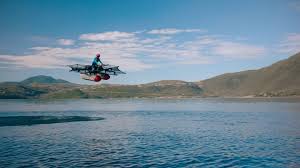
Breaking News
 China Will Close the Semiconductor Gap After EUV Lithography Breakthrough
China Will Close the Semiconductor Gap After EUV Lithography Breakthrough
 The Five Big Lies of Vaccinology
The Five Big Lies of Vaccinology
 Large global study analyzing data from 192 countries has sparked intense debate by suggesting...
Large global study analyzing data from 192 countries has sparked intense debate by suggesting...
Top Tech News
 EngineAI T800: Born to Disrupt! #EngineAI #robotics #newtechnology #newproduct
EngineAI T800: Born to Disrupt! #EngineAI #robotics #newtechnology #newproduct
 This Silicon Anode Breakthrough Could Mark A Turning Point For EV Batteries [Update]
This Silicon Anode Breakthrough Could Mark A Turning Point For EV Batteries [Update]
 Travel gadget promises to dry and iron your clothes – totally hands-free
Travel gadget promises to dry and iron your clothes – totally hands-free
 Perfect Aircrete, Kitchen Ingredients.
Perfect Aircrete, Kitchen Ingredients.
 Futuristic pixel-raising display lets you feel what's onscreen
Futuristic pixel-raising display lets you feel what's onscreen
 Cutting-Edge Facility Generates Pure Water and Hydrogen Fuel from Seawater for Mere Pennies
Cutting-Edge Facility Generates Pure Water and Hydrogen Fuel from Seawater for Mere Pennies
 This tiny dev board is packed with features for ambitious makers
This tiny dev board is packed with features for ambitious makers
 Scientists Discover Gel to Regrow Tooth Enamel
Scientists Discover Gel to Regrow Tooth Enamel
 Vitamin C and Dandelion Root Killing Cancer Cells -- as Former CDC Director Calls for COVID-19...
Vitamin C and Dandelion Root Killing Cancer Cells -- as Former CDC Director Calls for COVID-19...
 Galactic Brain: US firm plans space-based data centers, power grid to challenge China
Galactic Brain: US firm plans space-based data centers, power grid to challenge China
No Longer a Dream: Silicon Valley Takes On the Flying Car

CLEARLAKE, Calif. — On a recent afternoon, an aerospace engineer working for a small Silicon Valley company called Kitty Hawk piloted a flying car above a scenic lake about 100 miles north of San Francisco.
Kitty Hawk's flying car, if you insisted on calling it a "car," looked like something Luke Skywalker would have built out of spare parts. It was an open-seated, 220-pound contraption with room for one person, powered by eight battery-powered propellers that howled as loudly as a speedboat.
The tech industry, as we are often told, is fond of disrupting things, and lately the automakers have been a big target. Cars that use artificial intelligence to drive themselves, for example, have been in development for a few years and can be spotted on roads in a number of cities. And now, coming onto the radar screen, are flying machines that do not exactly look like your father's Buick with wings.
More than a dozen start-ups backed by deep-pocketed industry figures like Larry Page, a Google founder — along with big aerospace firms like Airbus, the ride-hailing company Uber and even the government of Dubai — are taking on the dream of the flying car.
The approaches by the different companies vary and the realization of their competing visions seems far in the future, but they have one thing in common: a belief that one day regular people should be able to fly their own vehicles around town.
There are challenges, no doubt, with both the technology and government regulations. Perhaps the biggest hurdle will be convincing the public that the whole idea isn't crazy.

 This is why RAM costs so much
This is why RAM costs so much

